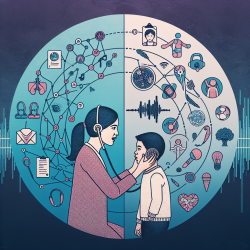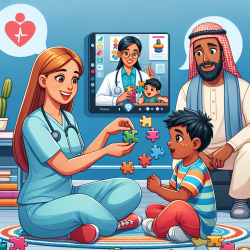Introduction
The study titled "Investigating Gaze of Children with ASD in Naturalistic Settings" offers valuable insights into the visual behaviors of children with Autism Spectrum Disorder (ASD). This research, conducted by Noris et al., explores how children with ASD engage visually in naturalistic interactions, providing crucial data that can enhance the skills of practitioners working with these children. Understanding these gaze patterns can inform better therapeutic strategies and encourage further research in the field.
Key Findings
The study highlights several critical findings regarding the gaze behavior of children with ASD:
- Children with ASD tend to look less and for shorter durations at faces during interactions compared to typically developing (TD) children.
- They display a preference for downward and lateral gaze, utilizing their peripheral vision more extensively.
- These behaviors are more pronounced in naturalistic settings compared to controlled laboratory environments.
Implications for Practitioners
For practitioners, these findings underscore the importance of understanding the unique visual engagement strategies of children with ASD. Here are some ways practitioners can implement these insights:
- Tailor Interventions: Recognize that children with ASD may not engage visually with faces as much as their peers. Tailor interventions to gradually encourage more direct gaze and eye contact in a non-threatening manner.
- Utilize Naturalistic Settings: Conduct sessions in environments that mimic natural settings to better observe and understand the child's gaze patterns and interactions.
- Focus on Peripheral Engagement: Design activities that leverage the child's tendency to use peripheral vision, gradually guiding them towards more central visual engagement.
Encouraging Further Research
While this study provides significant insights, it also opens avenues for further research:
- Longitudinal Studies: Conduct long-term studies to observe how gaze patterns evolve with age and intervention.
- Technological Integration: Explore the use of advanced eye-tracking technologies in various settings to gather more detailed data.
- Cross-Disciplinary Research: Collaborate with neuroscientists and psychologists to understand the neurological underpinnings of these gaze behaviors.
Conclusion
Understanding the gaze patterns of children with ASD is crucial for developing effective therapeutic strategies. Practitioners are encouraged to integrate these insights into their practice and to participate in or support further research to enhance our understanding of ASD. By doing so, we can improve the quality of life and learning experiences for children with ASD.
To read the original research paper, please follow this link: Investigating Gaze of Children with ASD in Naturalistic Settings.










